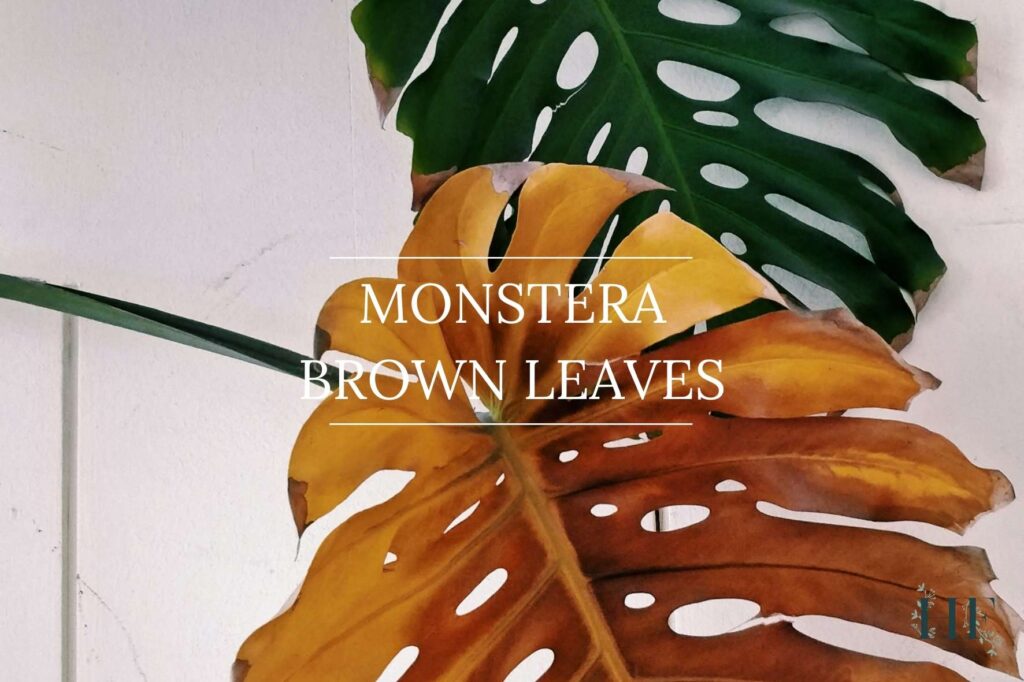Another common problem in Monstera plants, apart from yellowing leaves, is brown leaves.
There are many reasons that can cause your Monstera’s leaves to turn brown and it can be tricky to determine the cause.
If you are wondering why your Monstera has brown leaves, continue reading to find out more and what can you do to fix it.
Causes of Brown Leaves in Monstera
Why are my Monstera leaves turning brown?
Improper watering (both overwatering and underwatering), too much direct sunlight, low humidity (dry air), temperature stress, transplant shock (repotting stress), nutrient deficiency, fungal diseases and water quality are the main causes of brown leaves on Monstera.
Let’s see how to identify each cause and what to do to fix your Monstera going brown.
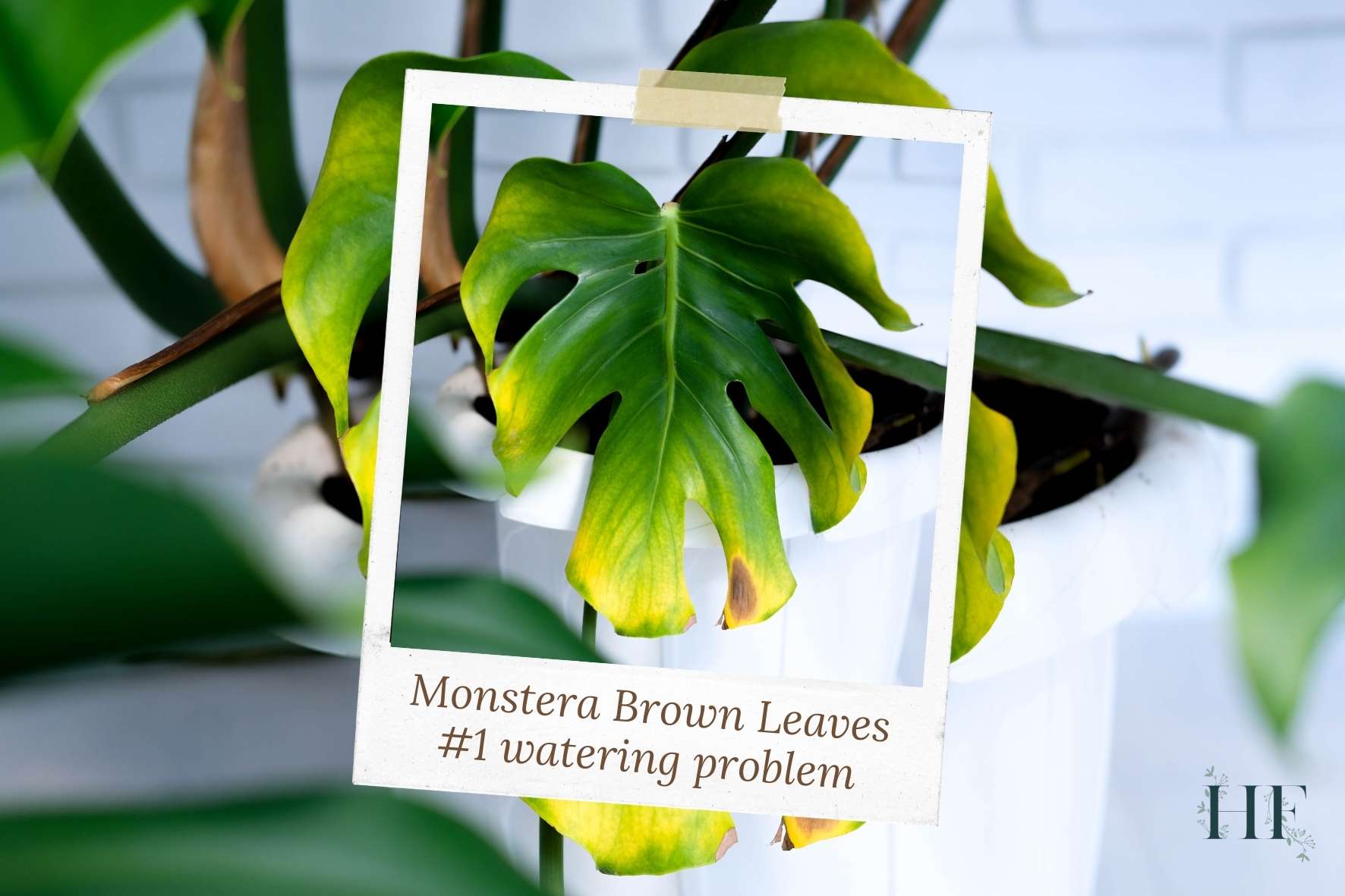
1) Watering Problem
Watering problems are a shared cause for both brown and yellow leaves in Monsteras.
When Monstera leaves are turning brown, one of the most common problems is watering: either overwatering or underwatering.
It can be challenging to assess how much water your Monstera needs, that’s why it is best to always check the soil first before watering, regardless if you are following a watering schedule or not.
An accurate way to check the moisture in the soil is using a moisture meter (this is the one I use and recommend).
- If the soil is wet, your Monstera is overwatered. If your soil feels wet less than 2 inches below the surface or reads wet (8-10) on your meter and you haven’t watered for a few days, your Monstera is waterlogged.
- If the soil is dry, your Monstera is underwatered. If the soil feels very dry more than a few inches down or reads dry (1-2) on your moisture meter, your Monstera plant needs water.
1.1) Overwatering Problem
When overwatered, apart from wet soil, you will notice your Monstera’s leaves will turn yellow first and then develop soft dark brown or black spots on those yellowing leaves.
Other overwatering signs include:
- Mould growing on the topsoil.
- A foul smell coming from the soil.
- Roots become mushy and black or brown (a.k.a., root rot).
Although Monsteras don’t like to dry out completely, they are susceptible to root rot if they stay wet for too long.
How to Fix Overwatering
If your Monstera plant is a little overwatered and not showing signs of root rot, simply give it a chance to dry out before watering it.
But, if your Swiss Cheese Plant is suffering from root rot, likely if you are seeing those soft brown spots or areas on the leaf, you will need to repot your Monstera as soon as possible, using a potting mix with better drainage.
Remember that overwatering is due to watering too often (especially during their dormant period). It can also occur due to heavy, poorly drained soil, oversized pots, or lack of drainage. If left to its own device, your Monstera will likely die.
1.2) Underwatering Problem
When underwatered, apart from the soil being dry, your Monstera’s leaves will turn yellow first and drop. Then, they will turn brown or get dry (crispy) brown spots or patches on their leaves.
Thankfully, underwatering is easier to fix (and much less likely to kill your Monstera).
How to Fix Underwatering
If your Monstera’s soil is severely dry and/or there are brown patches on the leaves, you can prune the affected leaves and water your plant thoroughly. Your plant will recover and those droopy leaves will perk back up.
However, you may need to adjust your Monstera’s watering schedule to be more frequent to avoid underwatering issues in the future.
For more, read Is My Monstera Overwatered or Underwatered? Signs & How to Fix.
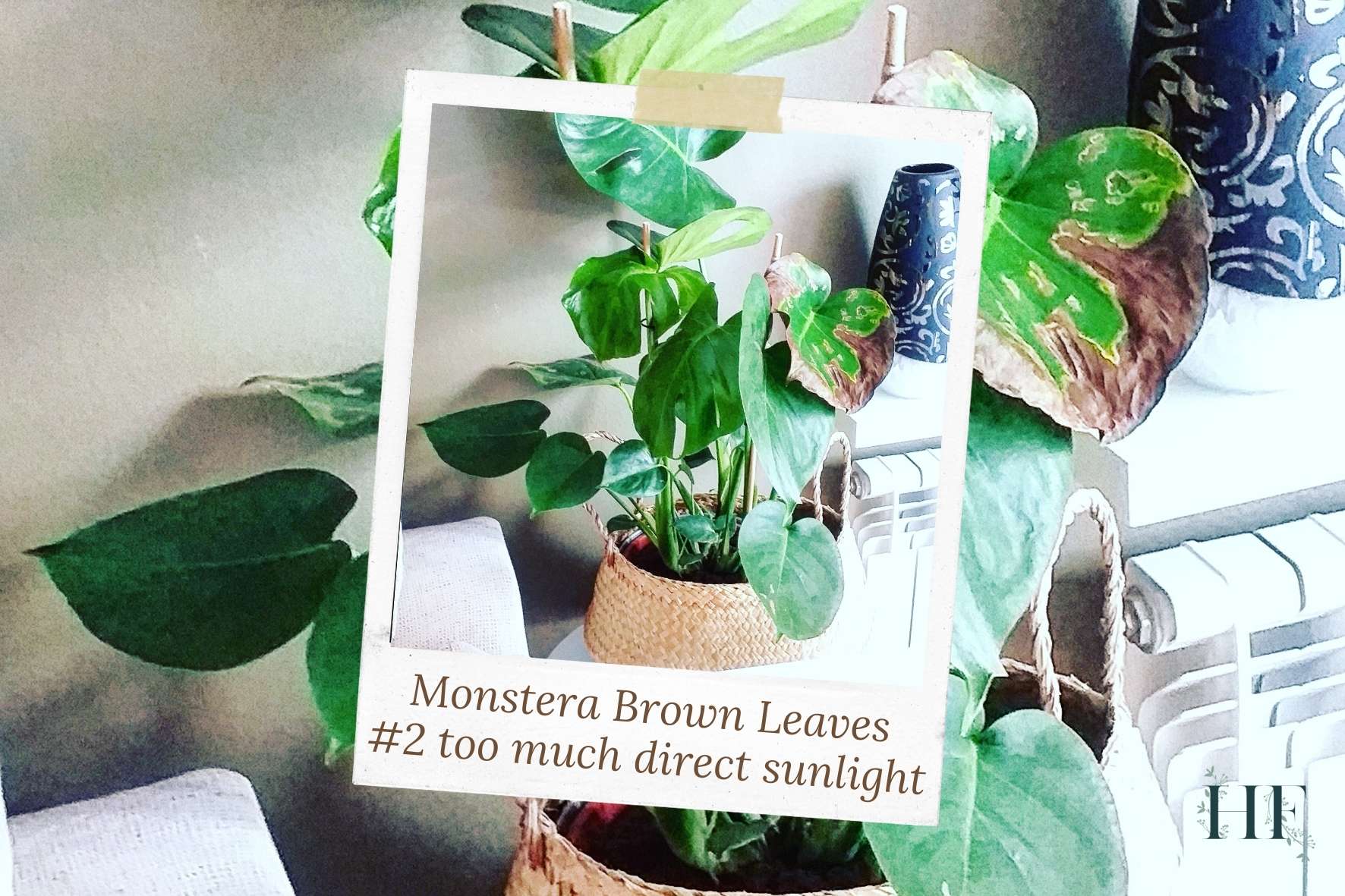
2) Too Much Direct Sunlight
Just like with water, Monsteras don’t like extremes when it comes to light either.
Monstera leaves turn brown when they receive too much direct sunlight. This causes leaf burn that looks like crispy brown spots or patches. The surrounding areas on the leaf can turn yellow.
These are sunburn spots, which are different from the soft brown or black spots that a Monstera gets when overwatered.
Remember that these plants thrive in bright, indirect light, which is less harsh than direct sunlight.
How to Fix Too Much Direct Sunlight Exposure
If the leaf is severely burned, it’s likely to die and fall off. Sadly, scorched leaves won’t recover.
However, if sunburn spots are minimal, you can leave them as they are and move your Monstera 2 to 4 feet (0.6 to 1.2 m) away from a bright window to prevent further damage. Another option is to diffuse the light by using net or voile curtains.
If you are unsure about how much light your Monstera is getting, you can use a light meter to check.
For more, read Monstera Light Requirements – How Much Does It Need?
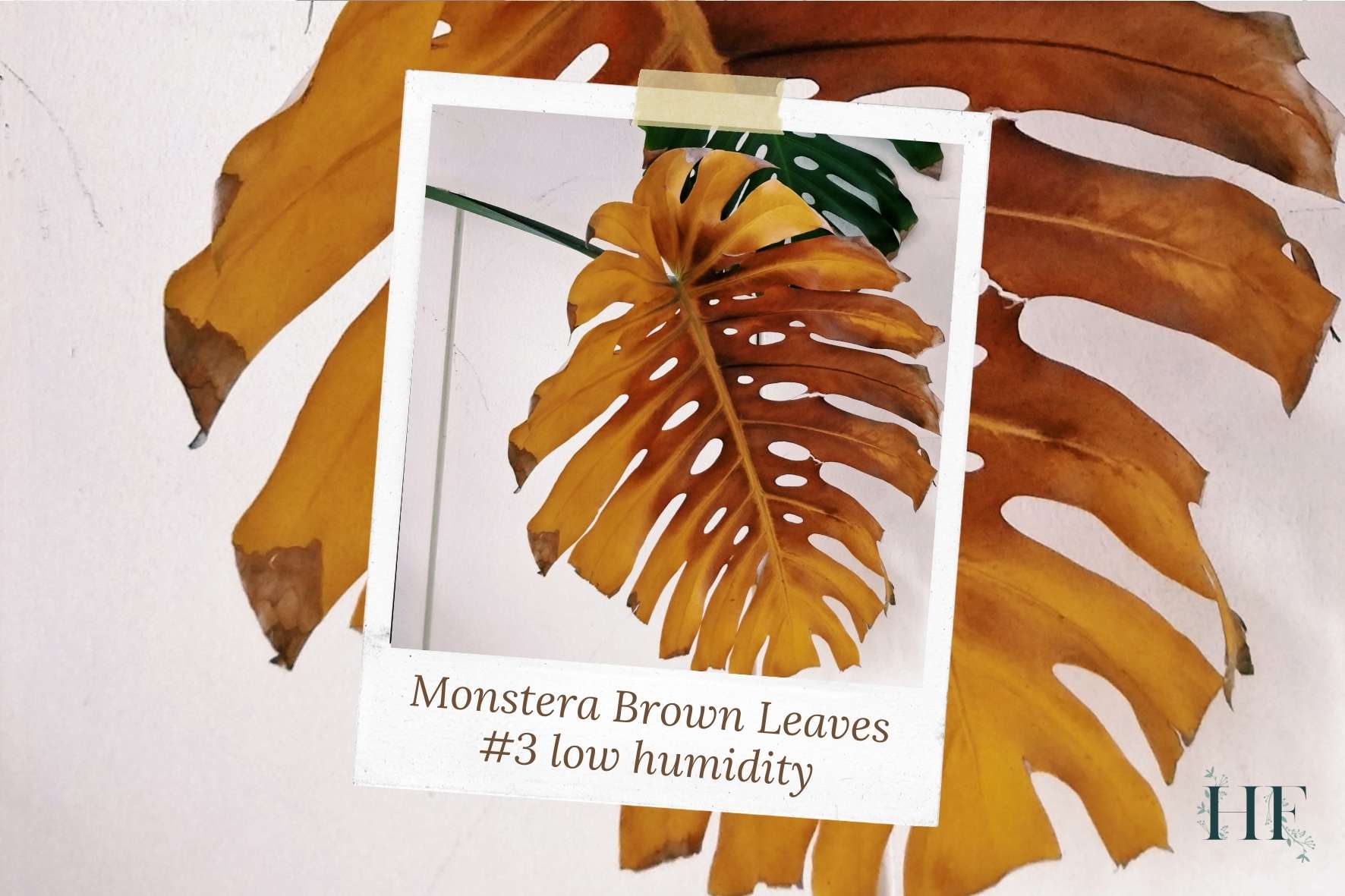
3) Low Humidity (Dry Air)
Although Monsteras can tolerate medium humidity levels (40 to 60%), they thrive in high humidity (above 60%) since high moisture levels are common in their natural habitat.
Low humidity also causes the browning of leaf edges, followed by a whole yellowing leaf. If the environment is very dry, the leaf surface will dry out.
Other signs of low humidity include:
- Yellowing leaves.
- Dry air in the room.
- Leaves curl at the tips and become crispy.
- Wilting and drooping leaves.
How to Fix Low Humidity
You can increase the humidity by using a humidifier, by far the best solution for humidifying an entire room, or a pebble tray.
Also, you want to keep your plant away from a radiator, which causes the air to dry.
To assess the humidity levels, you can use a hygrometer (which is what I use). This will allow you to adjust your Monstera’s growing conditions accordingly.
For more, read Monstera Humidity & Temperature Needs – 7 Tips to Get It Right.
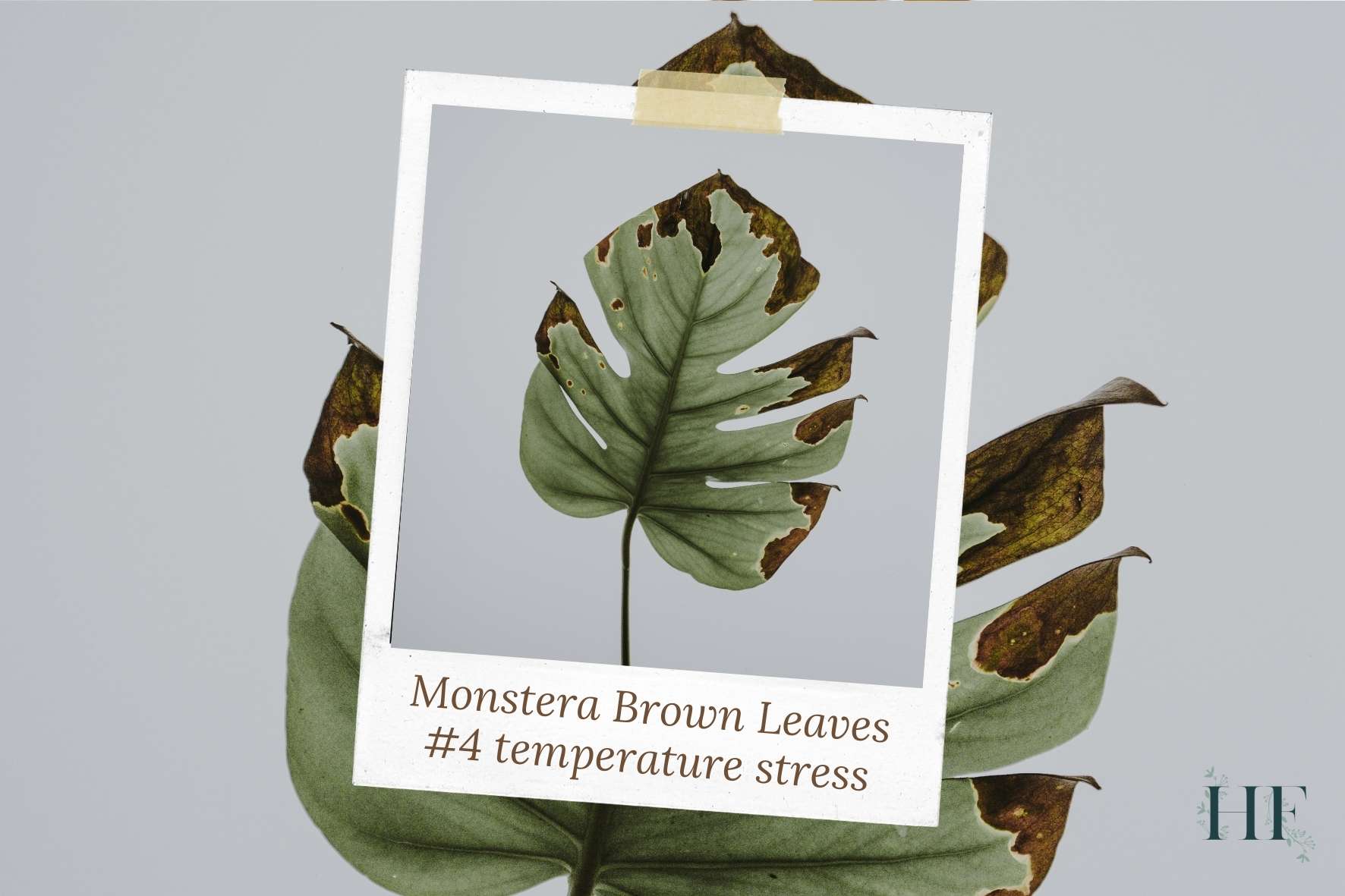
4) Temperature Stress
Your Monstera can get brown and yellow leaves due to extreme temperature changes. Its leaves can get crispy due to too low or too high temperatures. Younger, more tender leaves may be more susceptible to temperature stress.
In winter, once temperatures drop below 50°F (10°C), Monsteras will stop growing and their leaves will start to turn yellow. Also, since they cannot withstand frost, a light frost will cause the leaves to burn and turn brown; a stronger frost will kill your plant.
In summer, Monstera will also become stressed when exposed to extreme heat or direct, scorching sunlight.
How to Fix Temperature Stress
If you notice your Monstera’s leaves turning brown or/and yellow and feel crispy (dry) to the touch, assess its location:
- Is it next to a west-facing window where it gets strong afternoon sun?
- Is it next to a cold, drafty window in the winter?
- Is it next to the radiator or an air conditioner?
When that’s the case, it would be best to relocate your Monstera where the temperature will be more stable.
For more, read How to Care for Monstera in Winter – Can I Put It Outside?
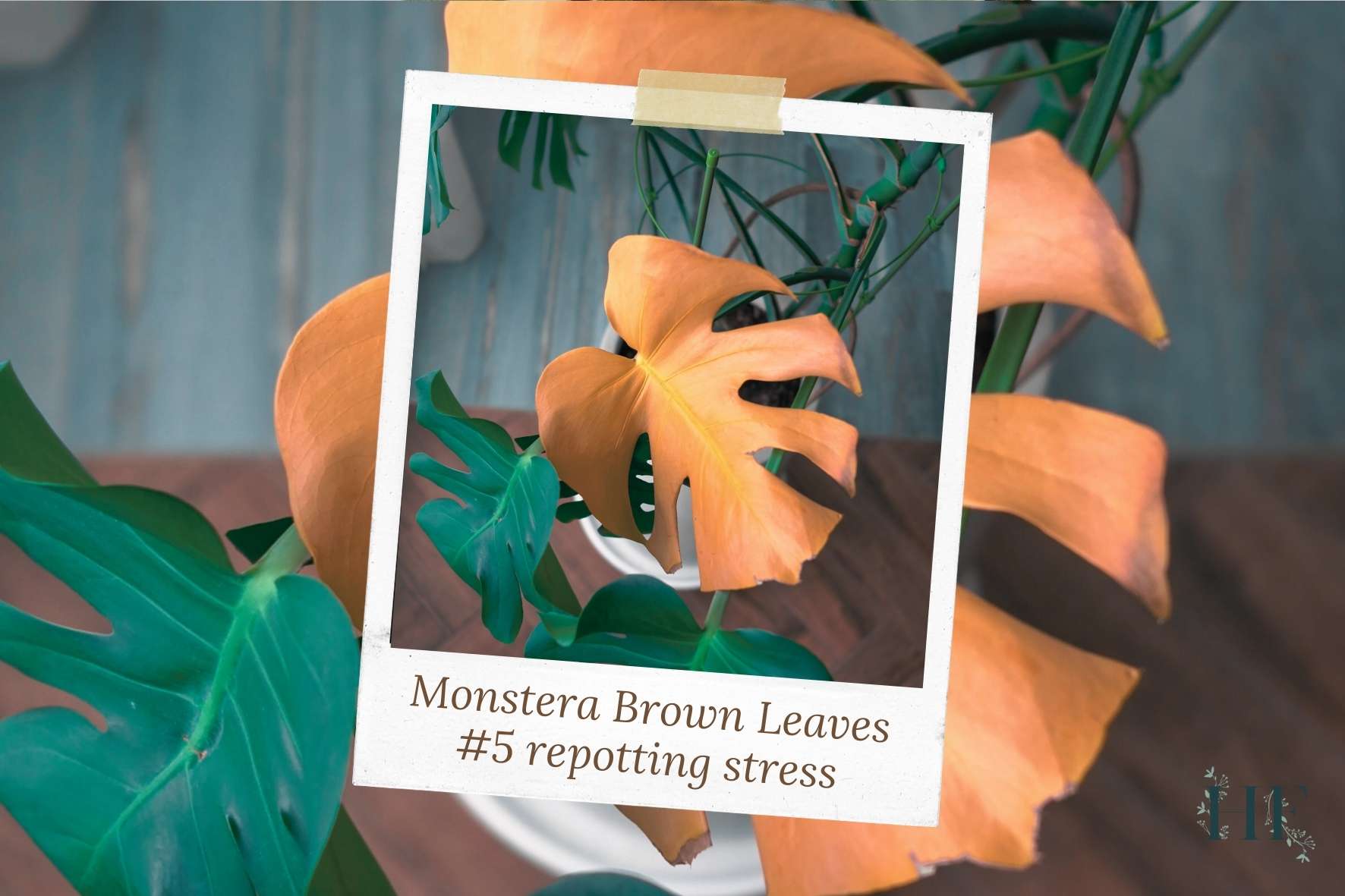
5) Repotting Stress
Your Monstera can develop droopy leaves than can turn yellow or brown after repotting. Repotted Monsteras can suffer from transplant shock due to the roots being exposed for too long, a change in soil, or even repotting at the wrong time of year (early spring is best).
The leaves turn yellow and then brown because the Monstera is trying to conserve nutrients and water after being repotted.
How to Fix Repotting Stress
Your Monstera will need some time to adjust to its new soil and pot, but it will bounce back to normal. Placing your plant back in its original location and maintaining the same growing conditions lessens the chances of transplant shock.
Also, it’s best not to fertilise for the next month since this can prevent the new roots from being burned.
For more, read A Guide to Repotting Monstera (When, Why and How).
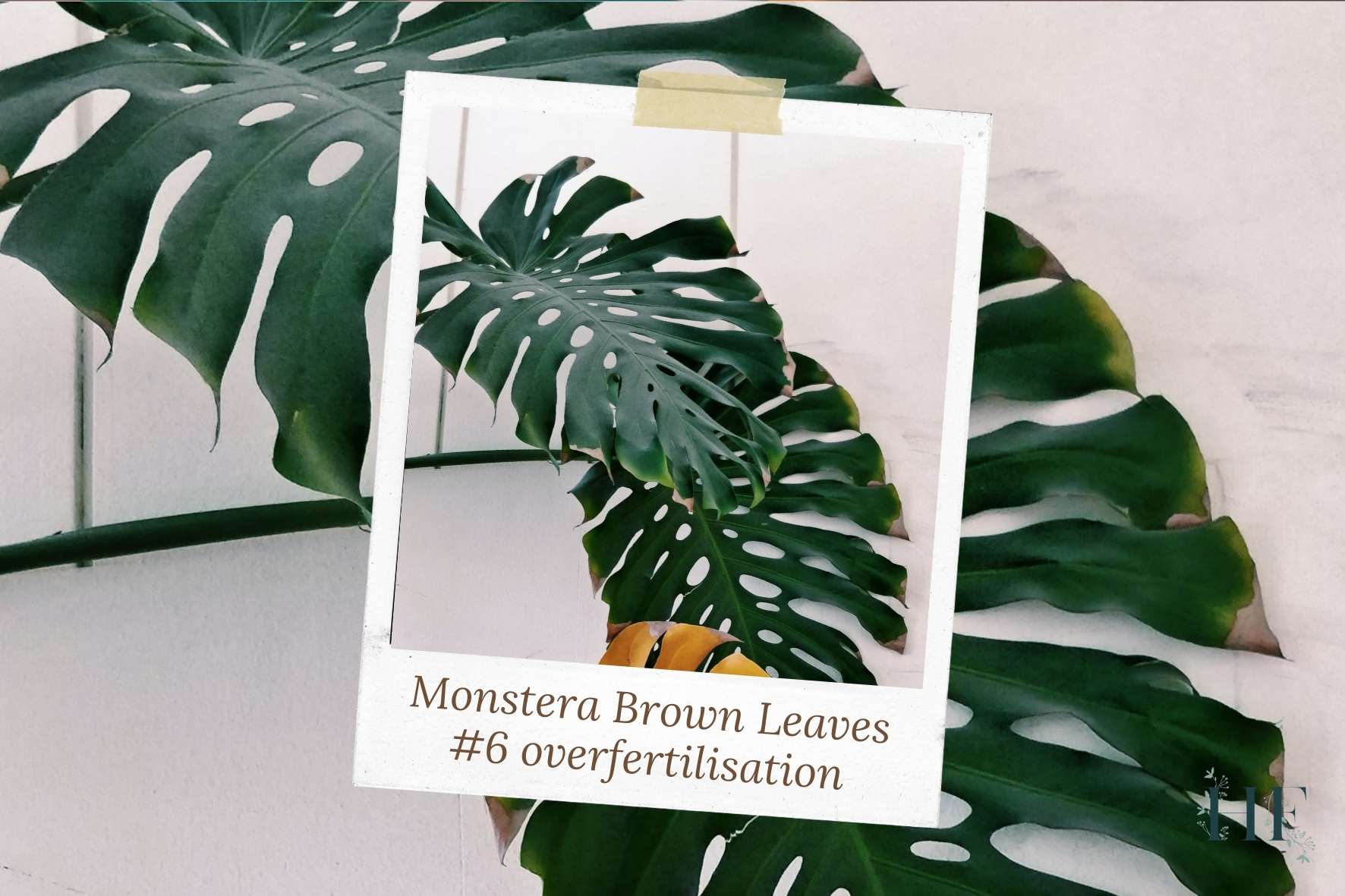
6) Overfertilisation
When your Monstera is overfertilised, its leaves turn yellow and brown on the edges. Those leaves’ edges also get crispy as they turn brown and the leaf dries out.
This happens because too many nutrient salts accumulate in the soil due to fertilising your plant too often or too much. The salt content alters the pH of the soil and causes salt burn (turning your Monstera’s leaf edges brown and crispy).
Other signs of overfertilisation include:
- A white crust on top of the soil.
- Wilting leaves.
- Slow or stunted growth.
How to Fix Overfertilisation
To fix an overfertilisation problem, flush the excess fertiliser out by running water through the plant’s soil until it drains from the pot’s bottom drainage holes.
Afterwards, just make sure that your Monstera plant dries thoroughly before the next watering to avoid overwatering. Also, you may want to wait a little longer than usual before fertilising your Monstera again.
To prevent future overfertilisation, you should reduce the amount and/or frequency of fertiliser. You can also consider switching to a gentler, organic fertiliser like this one, which has a lower concentration of macronutrients and therefore less likely to cause a salt burn.
For more, read A Guide to Monstera Nutrients (Why, When and How to Fertilise), which also includes a variety of fertilisers and which ones are more appropriate for Monstera plants.
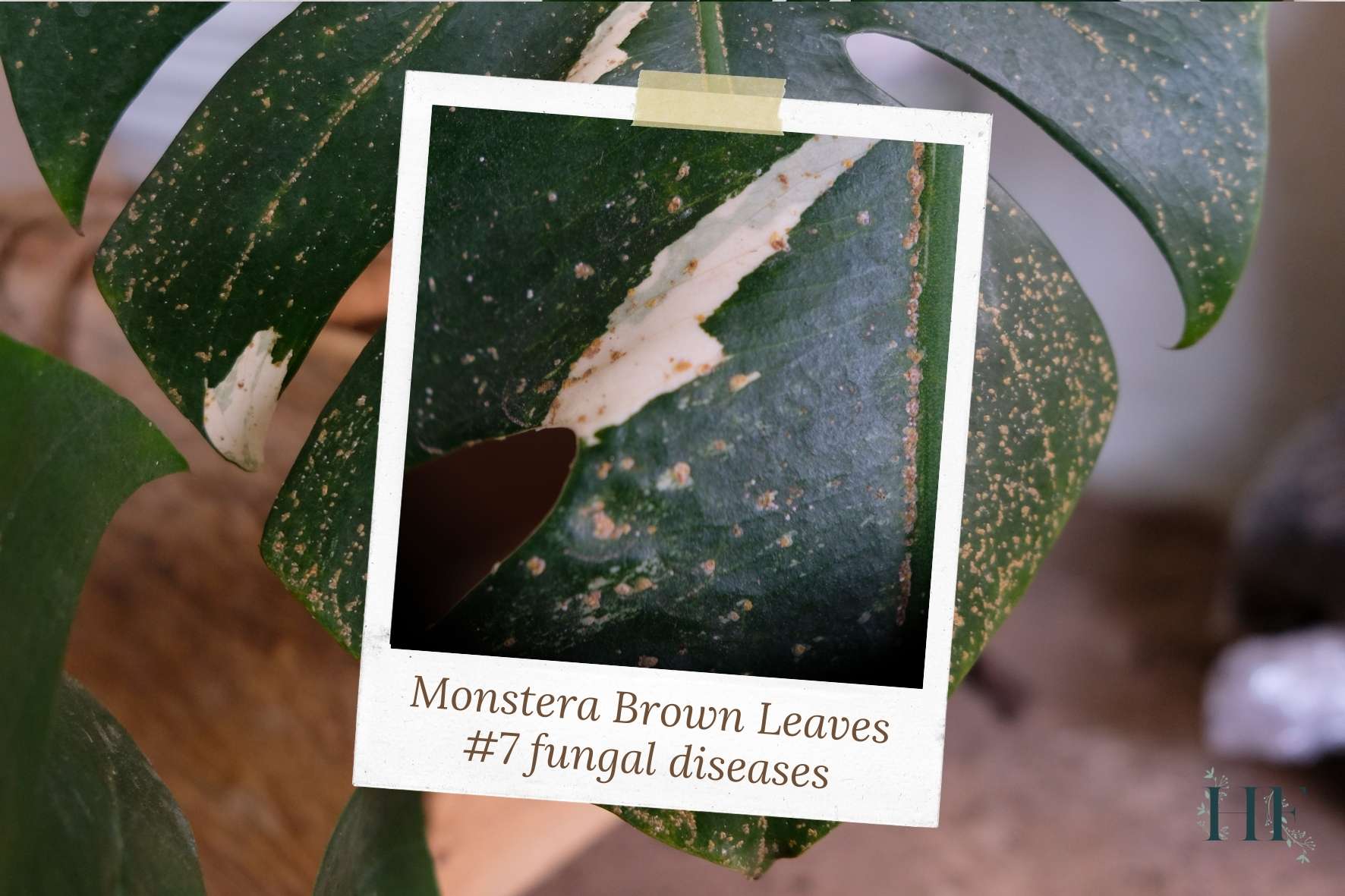
7) Fungal Diseases
Apart from root rot, which has been previously mentioned and is a fungus disease mainly caused by overwatering and low light conditions, there are two fungal diseases that cause brown spots on the leaves: eyespot disease (Spilocaea Oeagina) and anthracnose.
If the infestation is severe, the leaf will dry out and die.
7.1) Eyespot Disease
Eyespot disease (Spilocaea Oleagina) causes yellow halos or rings around brown spots on a Monstera’s leaves.
This disease is also referred to as peacock eye as the spots on the leaf look similar to eyes.
7.2) Anthracnose
Anthracnose is a fungal disease that starts with yellow or brown spots on the leaves. As the disease progresses, the yellow areas will turn brown, and the splotches will spread.
The discolouration can spread consuming the entire leaf and it can also affect the stem. Also, this disease will spread more rapidly in damp conditions (such as rain or frequent misting).
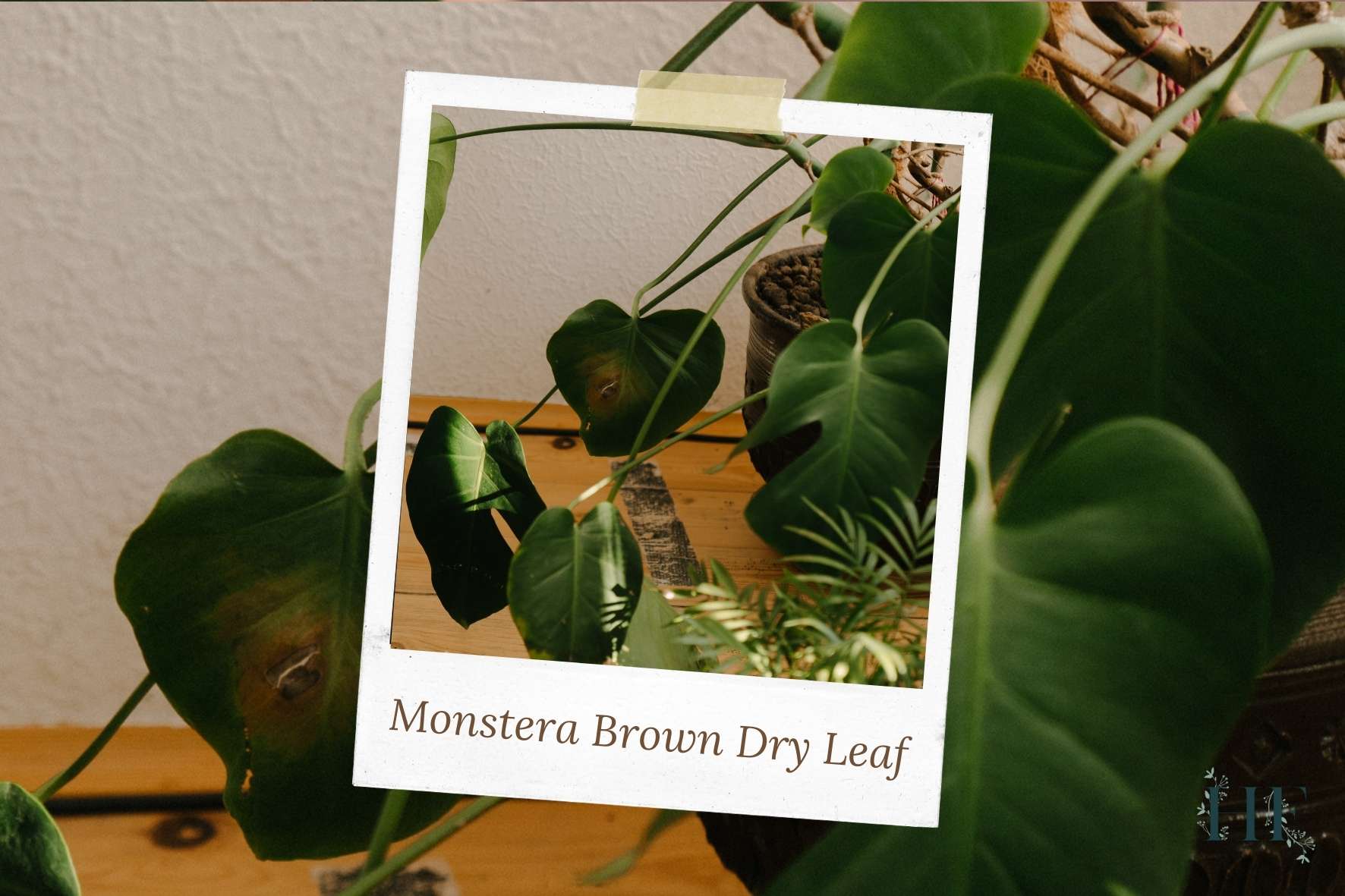
How to Fix Fungal Diseases
If you suspect your Monstera has eyespot disease or anthracnose, first isolate your plant from other houseplants to avoid the disease from spreading.
Then, remove the affected leaves and stems using sharp shears that have previously been disinfected. Also, disinfect your shears in between each cut by dipping them in white vinegar or rubbing alcohol.
Finally, you can spray your Monstera with a copper-based fungicide. This is a type of fungicide that is effective for treating fungal diseases. Alternatively, you can use a natural fungicide like cinnamon (brewed as a tea) or neem oil (diluted in water).
Neem Oil Fungicide Recipe: To use neem oil as a fungicide, mix a teaspoon of neem oil with a quarter of a gallon (1 litre) of water. Then add a couple of drops of dish soap to emulsify the mixture, and mix well. After, you can apply this mixture with a spray bottle.
By using a fungicide, you can make sure that you haven’t missed an affected area that hasn’t shown signs of disease yet.
Since fungal diseases thrive in wet conditions, including wet foliage, it’s best to mist your Monstera in the morning so the plant has enough time to absorb the water and dry out before night time. Also, you can improve the air circulation around your plant.
For more, read 11 Monstera Pests and Diseases Plus How to Get Rid of Them.
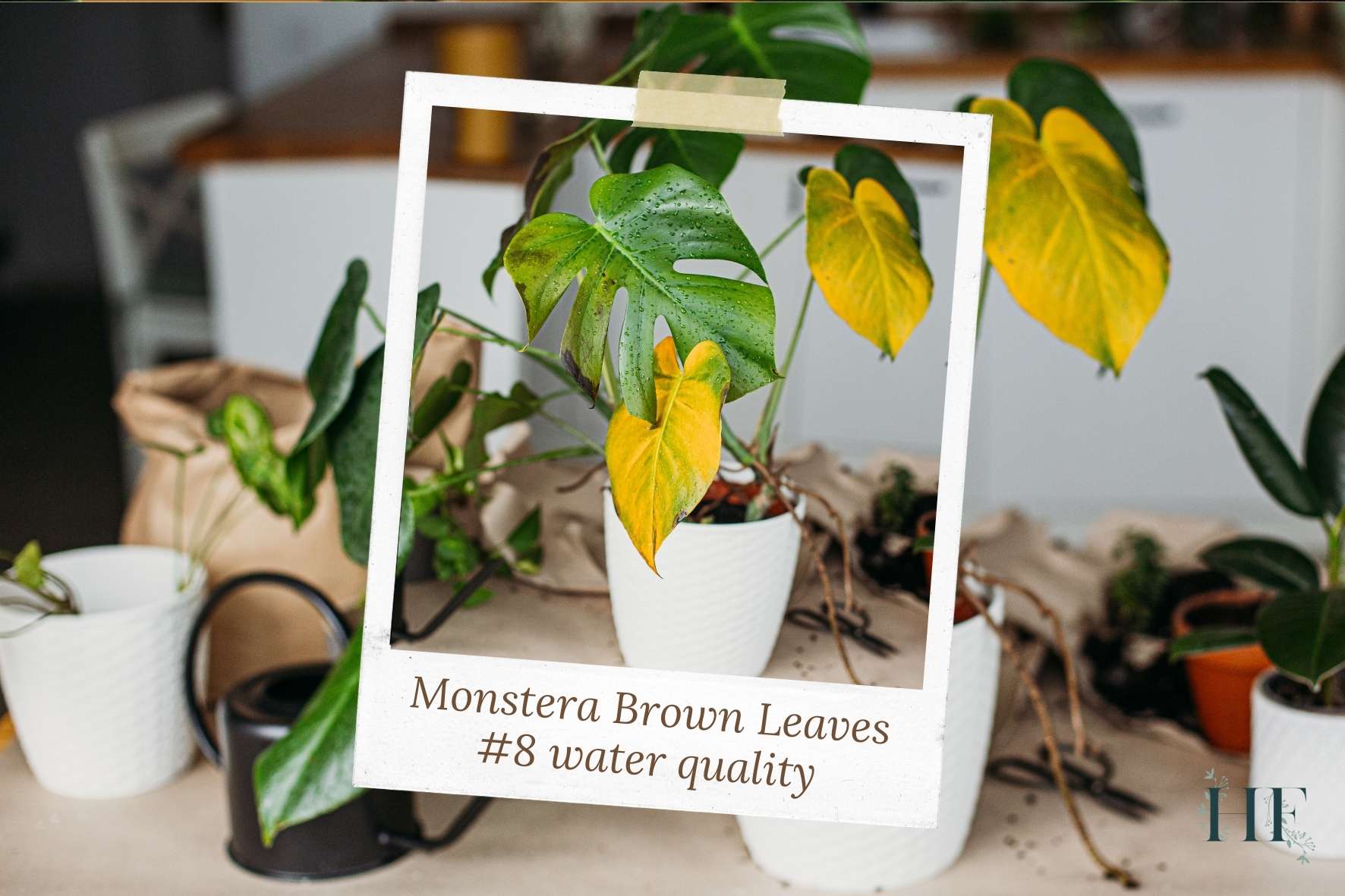
8) Water Quality
Finally, you might have not made the connection but the water you use in watering your Monstera (and other houseplants) can also affect its health.
Water that has fluoride can damage your plant and cause brown leaf tips on your Monstera (source).
If you notice your Monstera’s leaf tip going brown, you may want to test the quality of tap water in your area to make sure there’s no fluoride in it. You can use a fluoride test kit which also tells you about chlorine levels, hardness, pH, etc.
How to Fix Water Quality
Ideally, you should be watering your plants with rainwater, instead of using tap water which can contain fluoride or is classified as hard water due to its high contents in limescale.
Rainwater is the best type of water for Monsteras for many reasons:
- It already contains nutrients.
- It naturally imparts nitrogen to your plants in a form that is easy for them to absorb.
- It’s slightly acidic, which most plants prefer.
- Rainwater is far less likely than tap water to contain chemicals including chlorine and fluoride.
If you do not have access to rainwater, spring water and filtered water are also good options.
Avoid tap water unless you live in an area with high-quality tap water. If you have hard water, the excess buildup of minerals can prevent the plant’s root system from absorbing enough oxygen.
If you only have access to tap water, leaving it to sit out overnight can allow some of the chlorine to evaporate before you use it.
For more, read A Guide to Monstera Water Needs (How Often and When).
Related Questions
Should I Cut off Monstera Leaves that Are Brown?
After you determine the underlying cause of brown leaves and address the problem if there is one, you can prune your Monstera’s browning leaves.
To trim off brown leaves, cut as close to where they are attached to the stem as possible, without cutting the main stem or vine. Use a pair of disinfected sharp shears to make a clean cut.
Read also: A Guide to Monstera Pruning (How, When and Why).
Can Brown Monstera Leaves Recover?
Once a Monstera leaf turns brown it won’t recover. Any portion of a Monstera’s leaf that turns brown is dead.
Therefore, there is nothing you can do to fix it. Depending on the size and extent of the damage, you can either prune the whole leaf (when is mostly brown), trim the affected area (brown leaf tips) or leave it as it is (a spot in the middle of the leaf, for example).
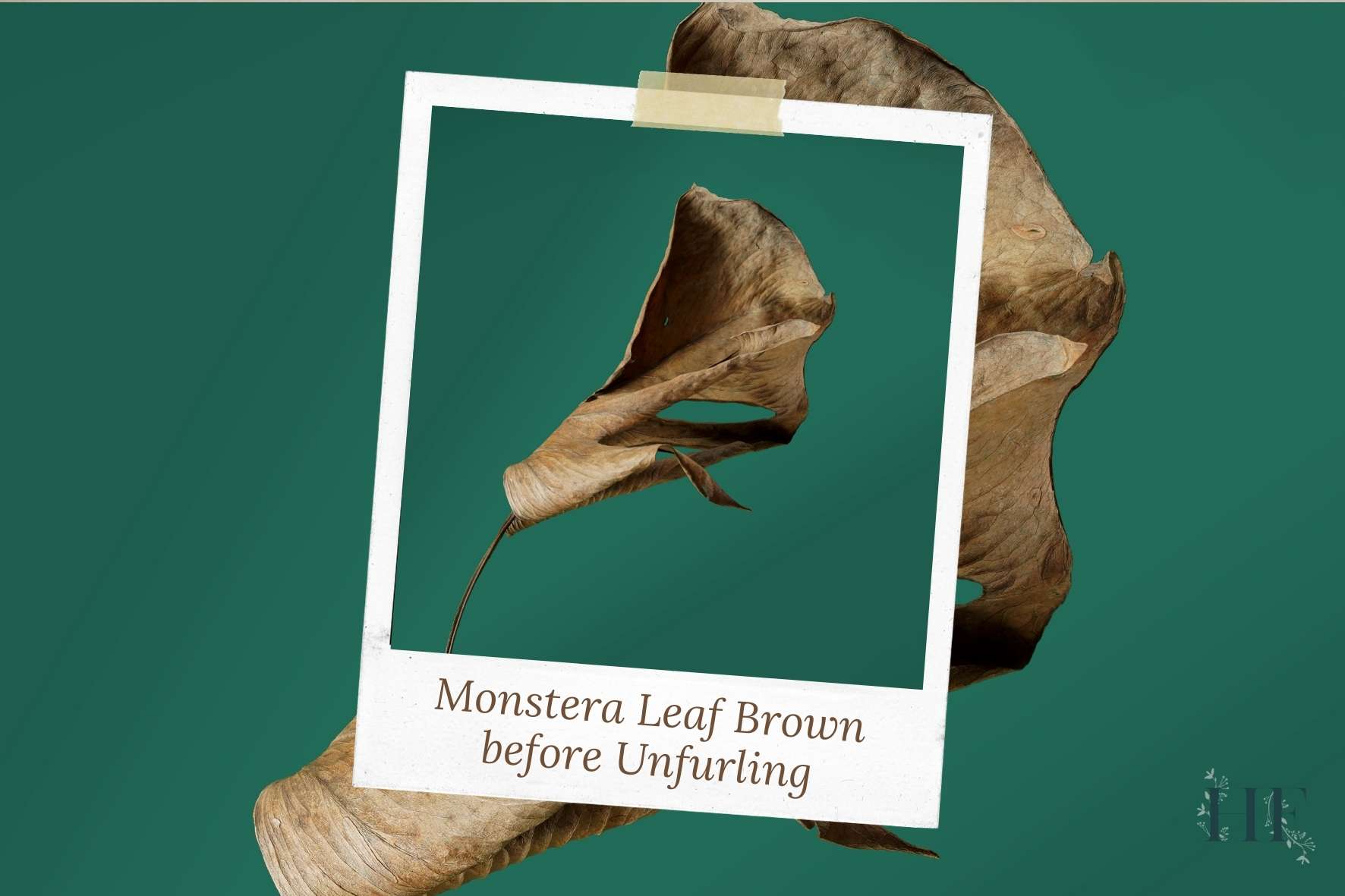
Why Has My Monstera Developed Brown Leaves Before Unfurling?
If your Monstera’s leaf has turned brown before unfurling is due to a soil moisture imbalance: the soil has been either dry or wet for too long.
This is likely caused by inconsistent watering, not checking the soil before watering or an inappropriate potting mix.

